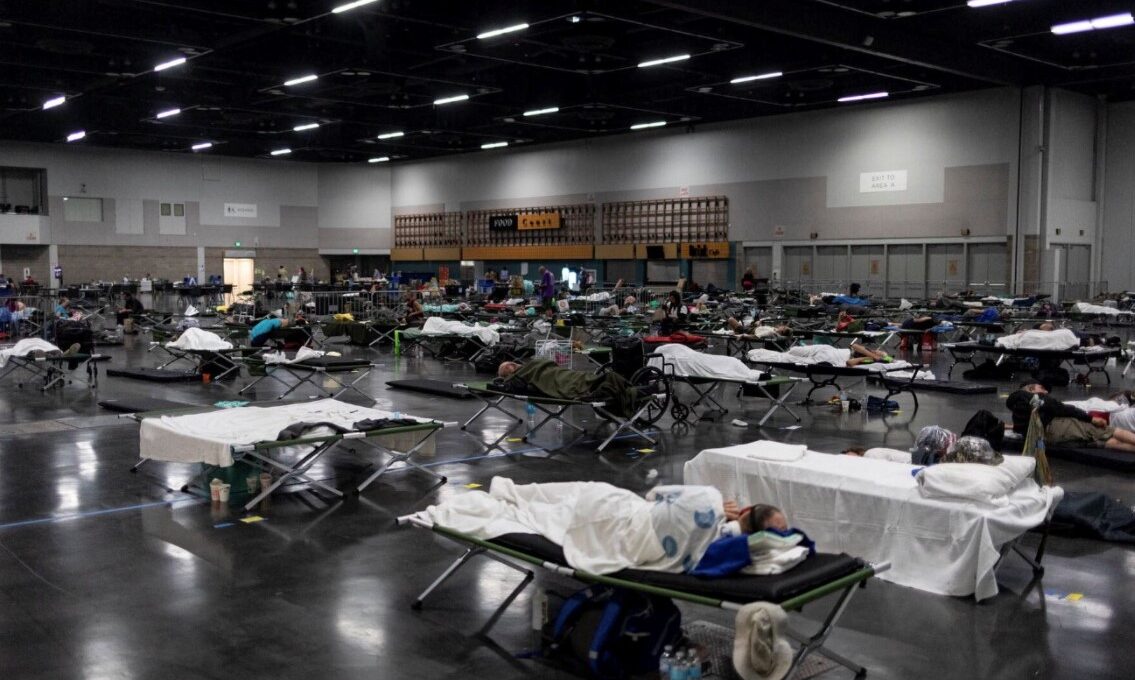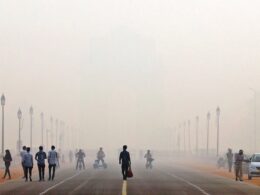Research has increasingly shown that warming is taking a deadly toll on human health. At the global climate summit in Glasgow, the issue has gained new prominence.
The New York Times
Winston Choi-Schagrin
November 4, 2021
Ambulances left the American Medical Response in Portland, Ore., in July during a record-breaking heatwave.Credit…Alisha Jucevic for The New York Times
For the first time at a major United Nations climate conference, human health is emerging as a leading issue, a reframing that brings climate change’s far-reaching and long-lasting effects to the forefront.
Although health has been addressed at conferences going back to the first U.N. environmental summit in 1992, never before has it held such a central role.
The 2015 Paris accord, the global agreement among nations to reduce greenhouse gas emissions, was billed foremost as a historic environmental moment.
However, “the Paris Agreement is not an environmental treaty,” said Dr. Maria Neira, the director of the World Health Organization’s department on environment, climate change and health. “It is a basic public health treaty.”
There is a growing body of research showing that climate change is contributing to a wide range of health risks around the world.
It is exacerbating heat waves, intensifying wildfires, heightening flood risks and worsening droughts.
These are, in turn, increasing heat-related mortality, pregnancy complications and cardiovascular disease.
And as with many things climate-related, the risks and harms are particularly severe in places that are the least able to respond.
There is a growing body of research showing that climate change is contributing to a wide range of health risks around the world.
There is also a cascade of indirect health consequences that threaten to unravel decades of progress on improving water quality and food security.
Drier soil can contribute to malnutrition.
Warming temperatures and changing humidity levels can expand habitats suitable to dengue- or malaria-carrying mosquitoes, lyme-carrying ticks,
and the pathogens that cause diseases like cholera and Valley Fever.
At the same time, two years of grappling with the coronavirus pandemic has underscored to politicians the importance of health as a national and global priority.
For reasons like these, the health community has strategized that if it can make people the face of climate change — rather than traditional environmental icons, such as polar bears or forests — political leaders may be more inclined to take action.
In the months leading up to the Glasgow conference, known as COP26, the world’s leading public health organizations, medical journals and professional organizations released a series of reports and editorials placing health at the heart of the climate issue.
One letter signed by organizations representing 47 million global health professionals declared the climate crisis “the single biggest health threat facing humanity.”
The World Health Organization estimates that between 2030 and 2050, at least 250,000 additional deaths will occur every year as a result of climate change.
One letter signed by organizations representing 47 million global health professionals declared the climate crisis “the single biggest health threat facing humanity.”
WHO … estimates that between 2030 and 2050, at least 250,000 additional deaths will occur every year as a result of climate change.
There are several signs of the emphasis placed on health this year!
In one sign of the emphasis placed on health this year, 15 countries, including Ireland and Mozambique, have already made significant pledges to decarbonize their national health systems.
“This year represents a quantum leap in how health is being covered at COP,” said Josh Karliner, the international director of program and strategy at Health Care Without Harm, an organization that has worked to reduce the health care sector’s environmental footprint.
Around the world, health care providers have said that they are already seeing the effects of climate change on their patients, as well as on the ability of hospitals to continue providing care during extreme weather.
At the same time, there has been a growing awareness of the health care sector’s own contribution to greenhouse gas emissions.
Hospitals weren´t designed for this challenges
Hospitals around the world have been hit hard by extreme weather and are increasingly grappling with the reality that they weren’t designed for the intensity of storms, heat and other challenges that are becoming more commonplace.
- Floods killed Covid patients at a hospital in Mexico.
- Hospitals in India suffered severe flooding.
- As wildfires burned on the West Coast, hospitals struggled to maintain their indoor air quality.
- A hurricane ripped the roof of a rural Louisiana hospital.
Pacific Northwest heat wave this summer, was an environmental emergency!
During the Pacific Northwest heat wave this summer, Dr. Jeremy Hess, a professor of emergency medicine at the University of Washington, was working in the emergency department at Harborview Medical Center, the highest-level trauma center for several states.
Dr. Hess has worked in emergency departments during mass casualty events, but the heat wave stuck out.
“It was more sustained,” he said. “It was an environmental emergency that wasn’t stopping.”
For days, patients came in with third-degree burns on their feet from walking on hot asphalt, he said. Many succumbed to heat-related death before even making it to the hospital. Doctors scrambled to have body bags filled with ice on gurneys.
Hospitals across the region were stressed in other ways.
Providence, a large health care organization in the West, had no spare beds at their emergency departments spanning the northern part of Washington state down to southern Oregon.
One hospital closed its psychiatric unit to ensure there was adequate power in more critical parts of the building.
That week, more than 1,000 heat-related emergency visits were reported in the Pacific Northwest, compared with fewer than 10 visits during the same period in 2019.
Researchers found that such an intensive heat wave would have been virtually impossible without the influence of human-caused climate change.
… such an intensive heat wave would have been virtually impossible without the influence of human-caused climate change.

Doctors say they have also seen the health effects of a changing climate in their day-to-day interactions with patients.
Allergy seasons are lasting longer, stressing her patients with asthma and lung diseases!
For years, Dr. Renee Salas, an emergency medicine doctor at Massachusetts General Hospital, said that she has noticed allergy seasons are lasting longer, stressing her patients with asthma and lung diseases.
She thought climate change may be behind it — and science has borne out her suspicions.
Studies have found that since 1990 pollen seasons have not only become longer but also contain higher pollen concentrations, and that climate change is a driving factor.
“I think about climate change as a secondary diagnosis in my patients,” said Dr. Salas, a co-author of The Lancet Countdown, a report on climate change and health.
… since 1990 pollen seasons have not only become longer but also contain higher pollen concentrations, and that climate change is a driving factor.
The health burdens are unlikely to be shared equally.
In September, a report from the Environmental Protection Agency found that although all Americans will be affected by climate change, minorities are likely to face more health risks.
Black Americans, for instance, are 40 percent more likely to live in areas with the highest increases in mortality due to extreme temperature.
“The same vulnerable communities that were disproportionately hurt by Covid-19 are bearing disproportionate harm from climate change,” Dr. John Balbus, the interim director of the U.S. Department of Health and Human Services’ Office of Climate Change and Health Equity, wrote in an email.
Meanwhile, there’s been growing recognition within the health industry of its own contributions to climate change.
It is estimated that the health care sector accounts for close to 5 percent of all global carbon dioxide emissions.
- Some of that comes from powering energy-intensive hospitals and clinics 24 hours a day,
- but the majority — an estimated 70 percent — is related to its supply chain and the energy required to produce, ship and dispose of the machines, pharmaceuticals and equipment used every day.
…the health care sector accounts for close to 5 percent of all global carbon dioxide emissions.
There is a trend towards Global Green and Healthy Hospitals
Over the past decade, 43,000 hospitals and health centers in 72 countries have signed on as members of the Global Green and Healthy Hospitals, a network of organizations aimed at reducing their environmental impact.
“It is a trend,” said Alison Santore, the chief advocacy and sustainability officer for Providence, the hospital chain, which is a member of the green-hospital group. “But it’s still the minority of hospitals when we look at the whole.”
Last year, in the midst of the pandemic, Providence pledged to go carbon negative by 2030, meaning that the company aims to remove more carbon dioxide from the atmosphere than it adds.
Health care centers and hospitals are 2.5 times as energy intensive as other buildings.
- Rooms and hallways are filled with computers and machines.
- Many items in hospitals are single-use to prevent infection.
- It is estimated that hospitals produce between 29 and 43 pounds of waste per patient per day.
“We are called to heal, and yet we are hurting the environment,” Ms. Santore said.
Health care centers and hospitals are 2.5 times as energy intensive as other buildings.
We are called to heal, and yet we are hurting the environment…
So far, the transition has not been easy.
Beth Schenk, a registered nurse and the executive director of environmental stewardship at Providence, said that meeting the company’s goals has required rethinking every aspect of their operations.
In addition to adding solar panels to roofs and transitioning to low-flow water, they’ve taken out water-intensive lawns and redesigned surgical kits.
Even for the few hospitals that have made progress, significant obstacles remain.
Clinica Biblica, a large hospital in San Jose, Costa Rica, achieved carbon neutrality by
- installing solar panels on its roof,
- purchasing carbon offsets,
- and otherwise relying on the country’s electric grid, which is powered by 99 percent renewable energy.
But its commitment to becoming carbon neutral along its entire supply chain will be a major challenge when there is little transparency over the greenhouse gas emissions of overseas suppliers and waste disposal.
Many health care providers are also learning that greenhouse gases can be found where you least expect them.
For instance, the main ingredients in essential medical tools like anesthetic gases and inhalers are actually potent greenhouse gases, like hydrofluorocarbons.
Despite their own efforts, though, health care leaders point out that it will be difficult for the industry to achieve carbon neutral goals without changes that are beyond their control, like the wider availability of renewable energy on the power grid.
Burning fossil fuels costs society $5 trillion on treating chronic disease, and air pollution results in 7 million premature deaths each year, said Dr. Neira, adding that “society needs to put that in the balance.”
Burning fossil fuels costs society $5 trillion on treating chronic disease,
and air pollution results in 7 million premature deaths each year …
Originally published at https://www.nytimes.com on November 4, 2021.
About the author
Winston Choi-Schagrin, is a reporting fellow for The New York Times, covering climate change and the environment.
Names cited
Dr. Maria Neira, the director of the World Health Organization’s department on environment, climate change and health;
Josh Karliner, the international director of program and strategy at Health Care Without Harm, an organization that has worked to reduce the health care sector’s environmental footprint;
Dr. Jeremy Hess, a professor of emergency medicine at the University of Washington;
Dr. Renee Salas, an emergency medicine doctor at Massachusetts General Hospital;
Dr. John Balbus, the interim director of the U.S. Department of Health and Human Services’ Office of Climate Change and Health Equity;
Alison Santore, the chief advocacy and sustainability officer for Providence, the hospital chain, which is a member of the green-hospital group;
Beth Schenk, a registered nurse and the executive director of environmental stewardship at Providence;












